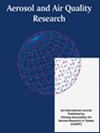西北典型污染地区农业土壤PM10和PM2.5的化学指纹图谱及来源特征
IF 2.5
4区 环境科学与生态学
Q3 ENVIRONMENTAL SCIENCES
引用次数: 0
摘要
分析农业土壤粉尘(SD)的化学源特征有助于准确评估和分配农业土壤粉尘对大气颗粒物(PM)的贡献。本研究旨在定量分析宝鸡市农业悬浮SD中PM 10和PM 2.5样品中的24种元素、8种水溶性离子、有机碳(OC)和元素碳(EC),了解农业悬浮SD的化学特征。结果表明,PM 10和PM 2.5粒径组分中元素组成的贡献率分别为40.18%和39.6%,其次是水溶性离子(PM 10为3.85%,PM 2.5为6.62%)和碳质组分(PM 10为3.46%,PM 2.5为2.36%)。由Al、Si、Ca、Ti和Fe浓度估算的重构地壳物质分别占总PM 10和PM 2.5的79.58%和78.8%,表明地壳物质可能是农业SD PM 10和PM 2.5质量的最重要贡献者。农业沙尘不仅受亚洲沙尘的远距离输运影响,还受到局地人为源的影响。pm2.5中较高的Sc、As、ca2 +、no3 -和nh4 +表明农业SD受到人为工农业活动的强烈影响。宝鸡样品中Si/Al、Ca/Al、K/Al、Fe/Al和Ti/Fe的比值与亚洲沙尘基本一致,表明亚洲沙尘的远距离输送对农业SD元素组成有重要影响。源鉴定发现,较高的nh4 + /Al、no3 - / ca2 +、no3 - / so42 -比值和OC可被认为是可能的源指标。本文章由计算机程序翻译,如有差异,请以英文原文为准。
Chemical Fingerprints and Source Profiles of PM10 and PM2.5 from Agricultural Soil in a Typical Polluted Region of Northwest China
Analysis of the chemical source profiles of agricultural soil dust (SD) can help accurately assess and apportion the contribution of agricultural sources to atmospheric particulate matter (PM). This study quantitatively analysed twenty-four elements, eight water-soluble ions, organic carbon (OC) and elemental carbon (EC) in PM 10 and PM 2.5 samples from agricultural resuspended SD to understand the chemical profiles of agricultural SD in Baoji city, Northwest China. The results showed that the elemental compositions in the PM 10 and PM 2.5 size fractions contributed 40.18% and 39.6%, respectively, followed by water-soluble ions (3.85% in PM 10 and 6.62% in PM 2.5 ) and carbonaceous fractions (3.46% in PM 10 and 2.36% in PM 2.5 ). The reconstructed crustal matter estimated from Al, Si, Ca, Ti, and Fe concentrations accounted for 79.58% and 78.8% of the total PM 10 and PM 2.5 , respectively, indicating that crustal matter may be the most significant contributor to agricultural SD PM 10 and PM 2.5 mass. Agricultural SD was influenced not only by the long-range transport of Asian dust but also by local anthropogenic sources. Higher Sc, As, Ca 2+ , NO 3– , and NH 4+ in PM 2.5 indicated that agricultural SD was strongly influenced by anthropogenic industrial and agricultural activities. The ratios of Si/Al, Ca/Al, K/Al, Fe/Al, and Ti/Fe in Baoji samples are basically consistent with those of Asian dust, indicating that the long-range transport of Asian dust had an important impact on the elemental composition of agricultural SD. Source identification found that higher NH 4+ /Al, NO 3– /Ca 2+ , NO 3– /SO 42– ratios, and OC can be considered possible source indicators.
求助全文
通过发布文献求助,成功后即可免费获取论文全文。
去求助
来源期刊

Aerosol and Air Quality Research
ENVIRONMENTAL SCIENCES-
CiteScore
8.30
自引率
10.00%
发文量
163
审稿时长
3 months
期刊介绍:
The international journal of Aerosol and Air Quality Research (AAQR) covers all aspects of aerosol science and technology, atmospheric science and air quality related issues. It encompasses a multi-disciplinary field, including:
- Aerosol, air quality, atmospheric chemistry and global change;
- Air toxics (hazardous air pollutants (HAPs), persistent organic pollutants (POPs)) - Sources, control, transport and fate, human exposure;
- Nanoparticle and nanotechnology;
- Sources, combustion, thermal decomposition, emission, properties, behavior, formation, transport, deposition, measurement and analysis;
- Effects on the environments;
- Air quality and human health;
- Bioaerosols;
- Indoor air quality;
- Energy and air pollution;
- Pollution control technologies;
- Invention and improvement of sampling instruments and technologies;
- Optical/radiative properties and remote sensing;
- Carbon dioxide emission, capture, storage and utilization; novel methods for the reduction of carbon dioxide emission;
- Other topics related to aerosol and air quality.
 求助内容:
求助内容: 应助结果提醒方式:
应助结果提醒方式:


